SS Hellenic Prince 1948-1954, ex HMAS Albatross 1928-1946
Please
Note: Firefox and some iPad’s or iPhone’s, etc are not suitable
Use Internet Explorer or Google for this page to load perfectly!
Click the logo above to reach the ssMaritime FrontPage for News Updates & “Ship of the Month”
Please
Note: All
ssMaritime and other related maritime/cruise sites are 100% non-commercial and
privately owned. Be assured that I am NOT associated with any shipping or cruise
companies or any travel/cruise agencies or any other organisations! Although
the author has been in the passenger shipping industry since 1960, although is
now retired but having completed over 700 Classic Liners and Cargo-Passengers
Ships features I trust these will continue to provide classic ship enthusiasts
the information the are seeking, but above all a great deal of pleasure!
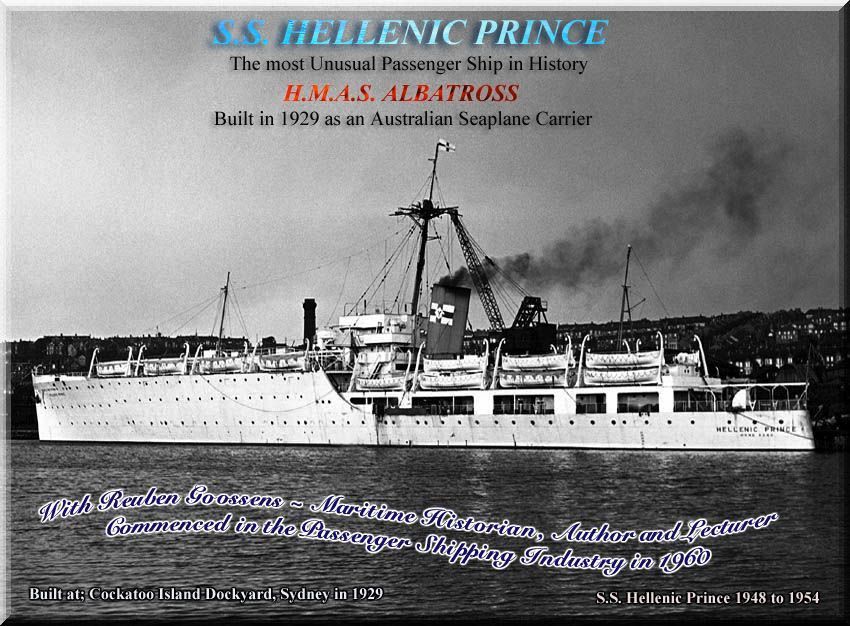
This feature
contains the story of what was, without a doubt one of the world’s most
basic passenger ships ever, yet she was give such a majestic and a princely
name such as the; “Hellenic Prince”. However, she was built
in 1928 as a humble Australian seaplane carrier the HMAS & the
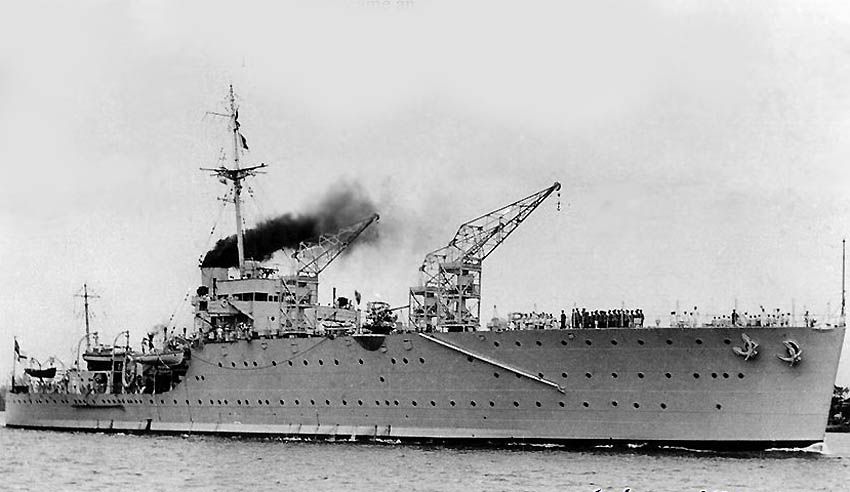
HMAS
Albatross is seen in the
Part Two
- S.S. Hellenic Prince
The Albatross
was sold to a British company the “South Western Steam Navigation
Company” on August 19, 1946 with the idea of rebuilding her into a
passenger liner to operate on the Australian market, and thus she was sent to
Chatham Dockyards for conversion. But it rapidly became obvious that the cost
of the rebuilding programme was going to prohibitive, therefore after a small
amount of work had been done, South Western formed a new plan for the vessel,
and they decided to use her as a storage facility. Thus, she was towed to
Torquay early in 1947, having been renamed the “Pride of Torquay.”
However, soon thereafter she was placed on the market, but as no buyers were
forthcoming an auction was organised which was to be held on October 19, 1948.
Then, just
several days prior to the auction date, she was purchased at a very good price
by the British-Greek “Yannoulatos Group” for their
“China Hellenic Lines” based in Hong Kong, and she would be
converted to operate migrant services to
The SS
Hellenic Prince was sent to the C. H. Bailey Ltd Shipyards, at Barry in
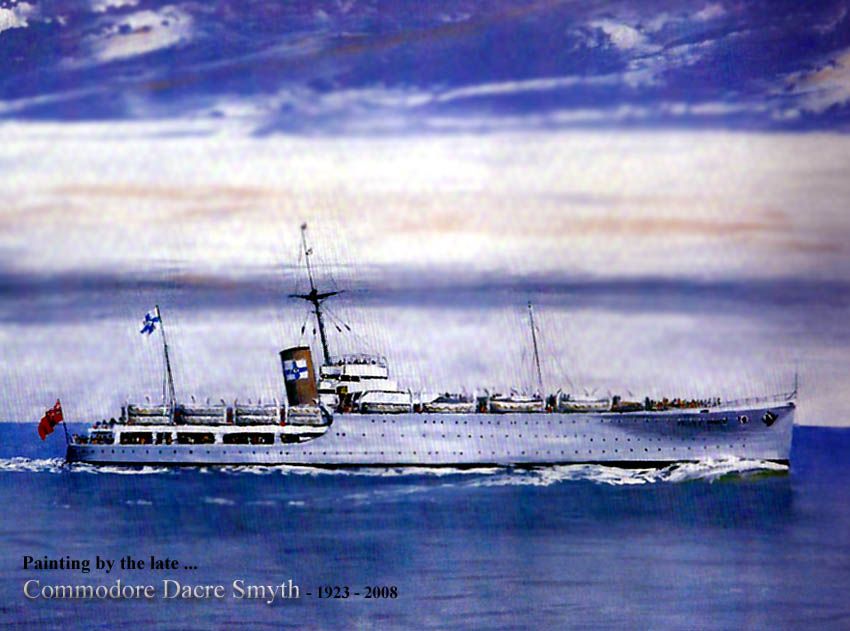
A Painting of the completed SS Hellenic Prince
The completed 6.558
GRT (Gross
Registered Tons) SS
Hellenic Prince was certainly no luxury liner, was able to accommodate up 1,200 persons in 200 cabins
and dormitories with up to 20 persons, as well some 8 and some 4 bunk cabins
all having the most basic of facilities, yet all accommodations were fully
air-conditioned. The spacious Dinning Room seated 560 persons and this venue at
certain times also was used as a lounge area, for there were no formal lounges,
but there were two Cinemas for entertainment. In the three bays of her hangar
deck there were three separate Hospitals - one for men, one for women, and an
isolation Ward for sick children who would most likely have come out of one of
the concentration camps of post-war Europe.
Specifications:
Built at: Cockatoo Docks and Engineering Co,
Tonnage: 4,800
Displacement.
Rebuilt: C. H. Bailey Ltd Shipyards, at Barry,
Tonnage: 6.558 GRT.
Length: 443.7ft - 135.70m.
Width: 61ft – 18.5m.
Draught: 17.25ft - 5.26m.
Propulsion: 4 × Yarrow boilers, Parsons Turbines, 12,000 SHP,
8,900 kW.
Speed: 17
Knots service speed, 22 maximum.
Propellers: Two.
Passengers: around
1,000, but up to 1,200 maximum in Steerage.
Crew: 250.
Her lower aft
deck had been covered providing a short Promenade Deck, but as it was very
close to the sea meant that on bad weather days it would have been
inaccessible! There was large covered area provided forward of the
superstructure for relaxation, and there was also a spacious aft deck, but
considering this very small ship carried so many passengers, her decks were
usually very crowded.
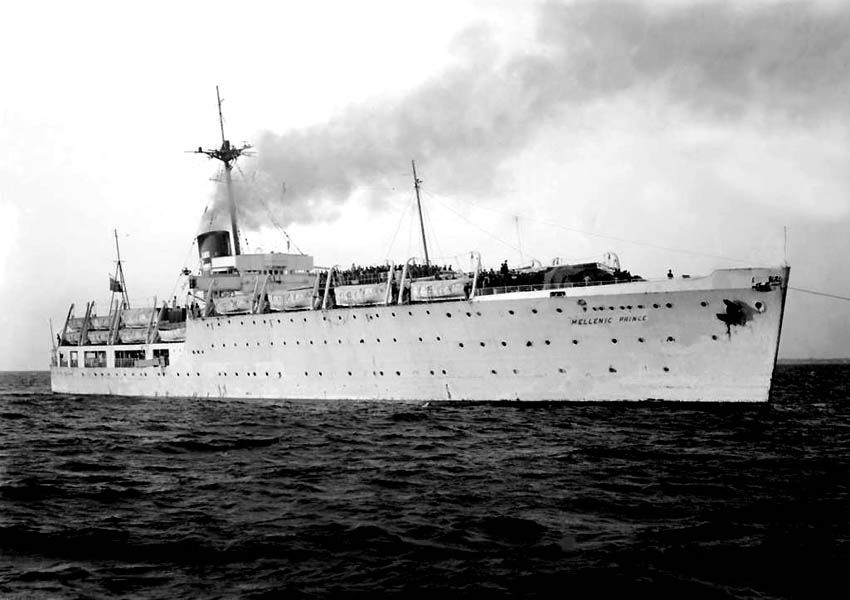
SS Hellenic Prince seen at Sea & you can see the two covered areas forward and the passengers crowded there
She departed
the C. H. Bailey Ltd Shipyards and headed for
During the
Hellenic Prince’s career she was also chartered by the
“International Refugee Organisation” (IRO) to transport both
individuals and families who would migrate to Australia and one voyage that
extended to New Zealand after World War II, who hailed from various European
Countries including; Germany, Hungary, Russia, Ukraine, Latvia, Poland,
Czechoslovakia and Romania, etc. The vast majority of these passengers are
World War II refugees or displaced persons.
Hellenic
Prince would sail at a service speed of 17 knots, meant that her voyages would
take an average of between 25 and 28 days. Her first voyage departed
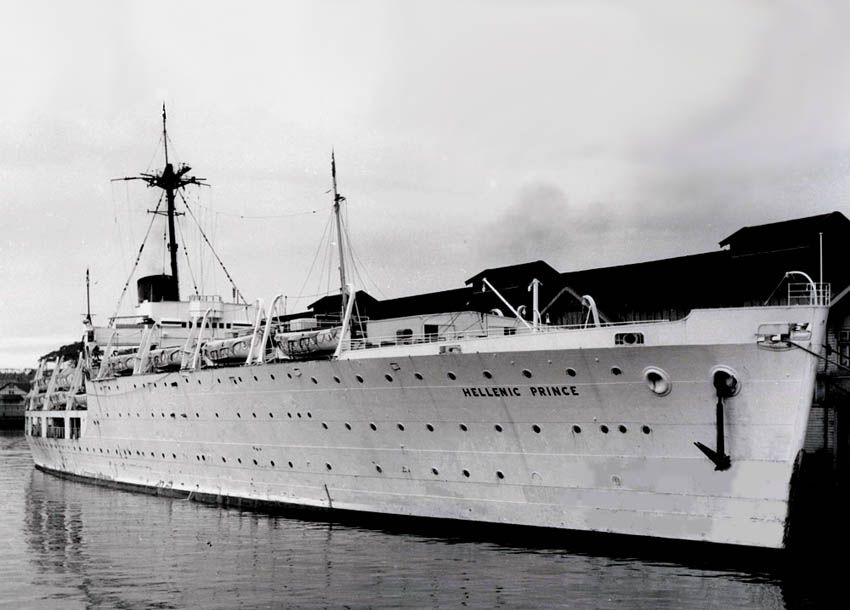
SS
Hellenic Prince is seen here berthed in
Once she had
offloaded her passengers, she departed and headed back to
Her next
voyage departed
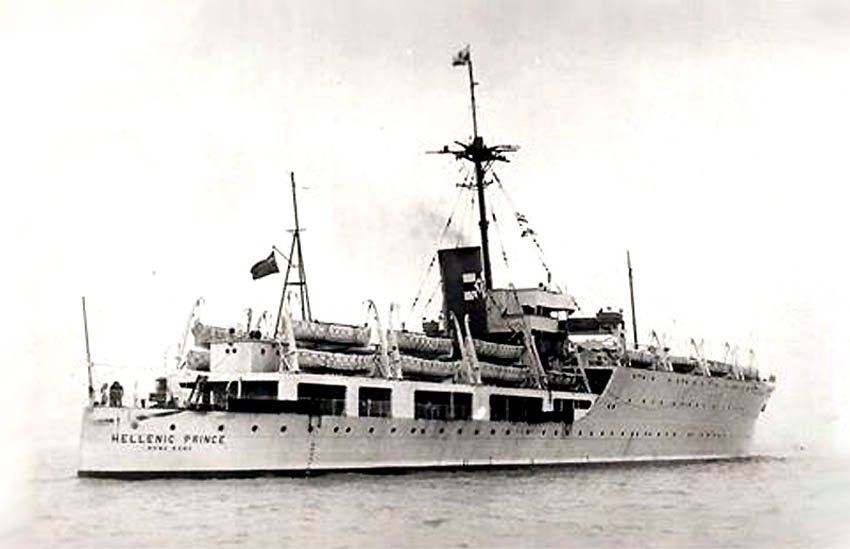
Here we see a stern view of the SS Hellenic Prince
Her third
voyage however, went without a hitch mechanically and she headed to
Her next
voyage was in September 1950 and she sailed via the
She the
departed later that day and headed directly along the Southern Sea & the
“Great Australian Bight,” and then across the Tasman Sea to
Wellington New Zealand where she arrived October 16 to off load her passengers
bound for New Zealand.
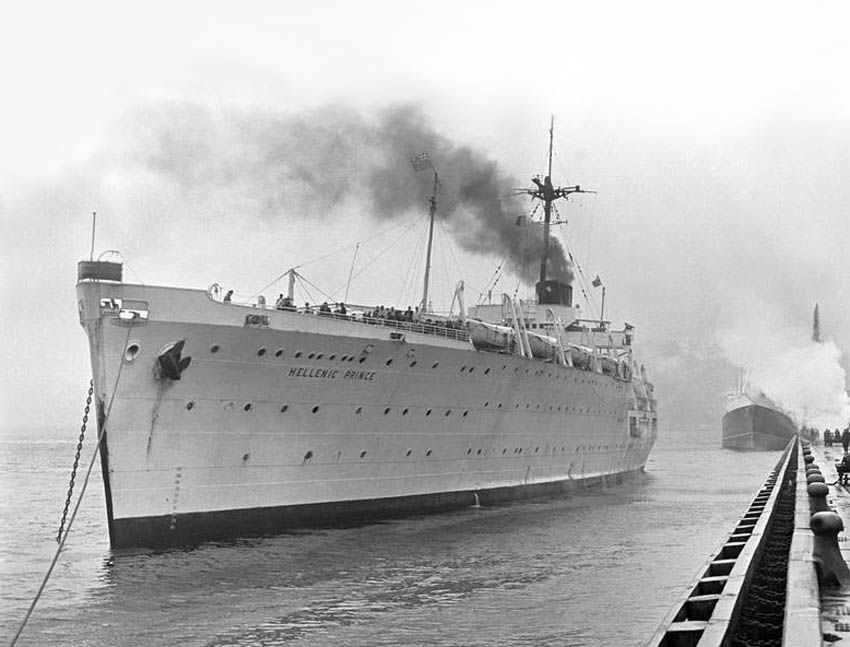
SS
Hellenic Prince is seen arriving in
She then
departed that same day and returned once again directly to Fremantle arriving
on November 2, and having bunkered there, she departed again and headed
directly north bound for Indonesia to board further Dutch ex-patriots and then
head for Bremerhaven.
Although she
remain on the Australian trade until 1952, but I have not covered her on board
experienced as reported so clearly by the captain and the passengers. AS we
read the following be well aware that “action was taken against captain
P. C. King and the company”.
Newsletter
“Kangaroo” January 5, 1951
A Newsletter
titled “Kangaroo” and dated January 5, 1951 was distributed on
board the Hellenic Prince during her 38 day voyage from (
This
newsletter was used by Mr & Mrs. Savo and Carla Krohnje who immigrated to
Passengers
were even required to work during the voyage, undertaking cleaning, cooking, mess
room duties, and working in the boiler and engine rooms, with payment received
in Woodbine cigarettes. Drinking water ran out before the end of the voyage,
although stubbies of drinking water could be purchased from passengers working
in the machinery room for US$1.00. A freezer breakdown saw precious food stuffs
perish, in addition passengers were refused permission to disembark at every
single port and when fresh food was finally obtained in Fremantle, it was given
to the crew, and not the passengers. Sea sickness was also rife as the ship was
rarely level due to a malfunction with the pumps thus they were unable to move
the ballast tanks around when needed.
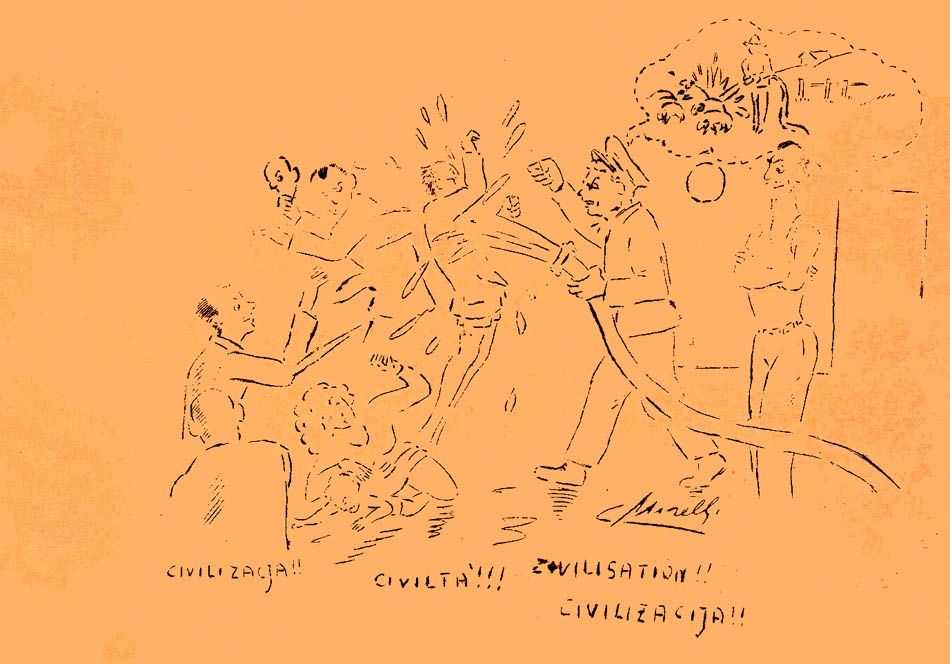
This drawing made by a passenger was to prove of the water & other tortures received from the hands of the captain & his crew
This image has been greatly cleaned up as the original I received was in a very poor state!
These
conditions resulted in increasing passenger discontent which culminated in a
hunger strike and the ship's master accused passengers of mutiny. A letter of
complaint was drafted and signed by all passengers and sent to the
“International Refugee Organisation”. On arrival at Bonegilla
Migrant Camp, they received news that the Hellenic Prince had been inspected
and action was taken against captain P. C. King and the company.

To view a larger, more readable version CLICK HERE
If the link does not work due to your system - Copy & Paste the following link that should suit your search engine;
www.ssmaritime.com/Hellenic-Prince-Kangaroo-Lge.jpg
West Australian News Paper
Article May 12, 1951
Below is a
copy of the “West Australian” News Paper printed in
Dated;
Saturday 12 May 1951, Page 2.
“Filthy”
Ship Habits Of Migrant Groups.
“Their
habits have been filthy and they were a constant worry to the crew,” the
master of the migrant vessel Hellenic Prince Captain. P. C. King said at
Fremantle last night about Syrian. Lebanese and Cypriot peasants aboard the
ship. “Some of them are not even white,” Capt. King said.
‘They came on board from the mountains of
Capt. King,
who is a former British naval officer, said that he was as surprised as some of
his passengers-particularly the 29 French men and women on board-when Syrian,
Lebanese and Cypriot peasants joined the ship.
“Some
appeared to have the mentality of children,” he continued. “It has
been difficult to keep the ship clean, particularly in their dormitory.”
During the
past five voyages to
“Luxury"
Claim.”
“The
displaced persons gave us less trouble because they were well
disciplined,” Capt. King said. “Many of the people on this voyage
have not the slightest idea of what discipline is. They became obstreperous at
Another
officer said that although he had seen thousands of displaced persons coming to
